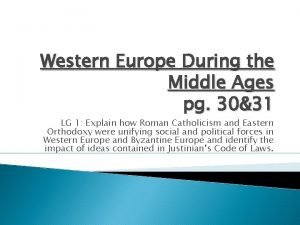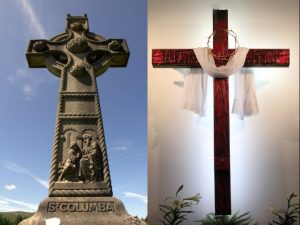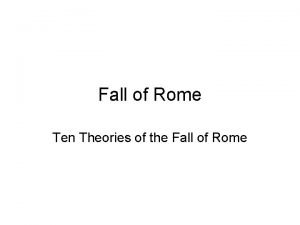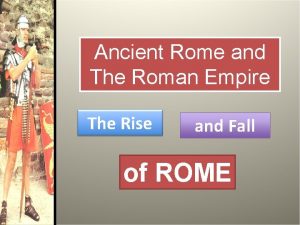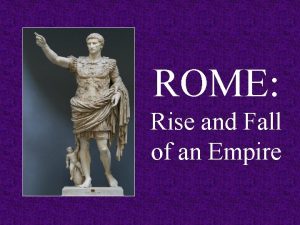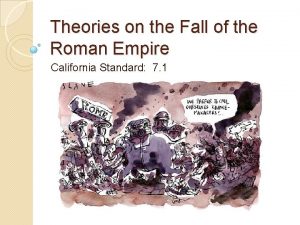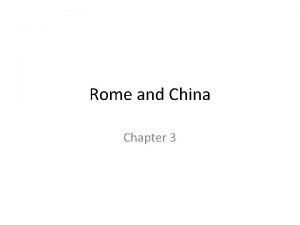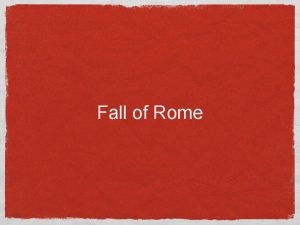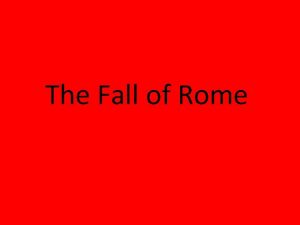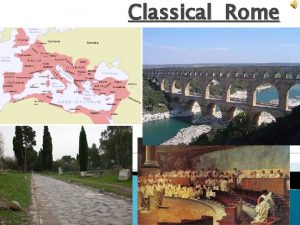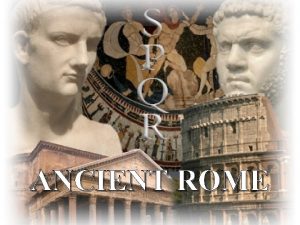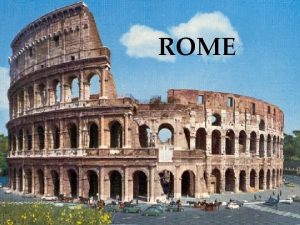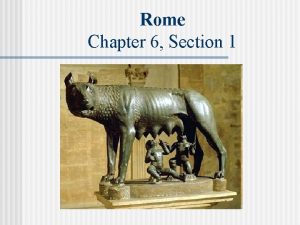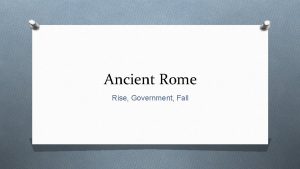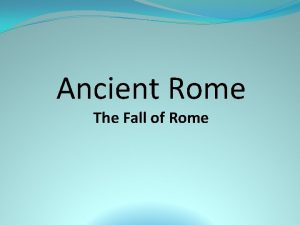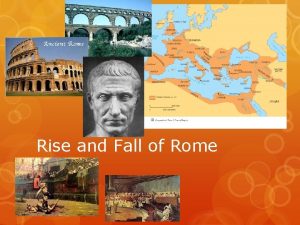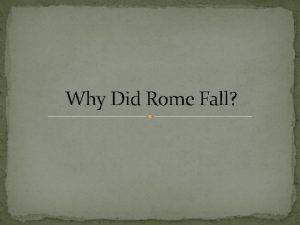Chapter 9 Section 3 The Fall of Rome
















- Slides: 16

Chapter 9 Section 3 The Fall of Rome

Emperor Constantine “Under this sign you will Conquer!” Constantine, Rome’s emperor from A. D. 312 to 337 strongly encouraged the spread of Christianity

From Good Rule to Bad v After Marcus Aurelius, the last of the good emperors, died, his son Commodus took power in 180. v The rule of Commodus marks the beginning of the fall of the Roman Empire. v Commodus was a terrible leader who showed little use for the senate and loved the bloodshed of the Gladiator games. v Commodus was assassinated on New Year’s eve in 192

The Empire Crumbles The Decline of the Roman Empire began under Commodus. However, historians do not agree on any one reason for the decline, instead they believe there were several problems that led to the Fall of Rome. ************** ü Weak, Corrupt Rulers ü Mercenary Armies ü Empire Too Big ü Serious Economic Problems **************

v Emperors after Commodus were almost always successful generals and not politicians. v Most of them stole money from Rome and used it to enrich themselves v Government and economy became weak v Between A. D. 180 and 284, Rome had 29 emperors…most were assassinated for being terrible. Weak, Corrupt Rulers

A Mercenary Army ü Early in the Roman Empire citizen soldiers fought to defend their land beliefs. ü Later in the empire mercenaries, soldiers who serve for pay, were hired to fight for rome, but they were motivated by money, not loyalty or cause. What am I fighting for again…?

Size of the Empire The Roman Empire became too big to defend. Enemies launched attacks from all over the empire. Many conquered territories regained independence and the empire shrank.

Serious Economic Problems ü When Rome stopped conquering new lands, new sources of wealth were no longer available ü To raise money, the government raised taxes. Meanwhile, the people of the empire suffered severe unemployment. ü Food was scarce, so its price went up. To pay for food, the government produced more coins at less value.

Efforts to Stop the Decline Ø Diocletian enlarged the army, built new forts at the borders, and improved the tax system. Ø Diocletian also divided the empire into two parts to make it easier to rule. He ruled the wealthier eastern part of the empire, and appointed a co-emperor to rule the western part.

Constantine & Christianity v Diocletian and his coemperor stepped down in A. D. 305. A struggle for power followed. For seven years, generals fought one another for power until one —Constantine—became the winner v The victory at the bridge over the Tiber made Constantine sole ruler of the Roman Empire in the West. In the East Licinius would take control in A. D. 313

v In 313, Constantine and Licinius proclaimed freedom of worship for people across the empire. v Christians had been tortured and punished for their beliefs. Now Rome would no longer persecute the Christians. v Christianity would soon became the official religion of the Roman Empire. Freedom of Religion

Another Christian Victory Ø In 324 Constantine won several battles against Licinius for control of the eastern half of the Roman Empire. Ø Licinius and Constantine had agreed to tolerate all religions when they began sharing power in 313, Licinius had continued to allow the persecution of Christians in the East. Ø Constantine saw his victory over Licinius as further proof that the Christian God was working through him.

Building A Faith ü During his 25 years as emperor, Constantine worked to strengthen the Christian church. ü Constantine was a leading force behind the construction of important Christian places of worship. ü He helped plan and pay for the construction of a church in Jerusalem on the spot where Jesus was crucified, buried, and is said to have risen from the dead. St. Peters Church in Rome that Constantine helped build

A New Capital v In 330, Constantine moved the capital of the Roman Empire east to the city of Byzantium (Turkey Today) v When he dedicated the city as the new capital of the empire, he called it New Rome v The new capital became known as Constantinople “City of Constantine”

Invasions & Collapse v Constantine struggled to keep the empire together, but the forces pulling it apart were too great. v Germanic tribes including the Visigoths and Vandals invaded Rome and overwhelmed the empire v The last Roman emperor was 14 year-old Romulus Augustulus v After Romulus Augustulus, no emperor ruled over Rome v Constantinople became the capital of the Byzantine Empire which lasted for the next 1000 years.

Let’s Review 1. What is the name of the emperor who encouraged the spread of Christianity? 2. Whose rule marked the beginning of the fall of the Roman Empire? 3. What is a soldier who serves for pay called? 4. Which emperor divided the Roman Empire into two parts? 5. What is the name of the city that became the capital of the Byzantine Empire?
 Western europe after the fall of rome
Western europe after the fall of rome What event marked the fall of rome in 476 c.e.?
What event marked the fall of rome in 476 c.e.? Fall of rome
Fall of rome Ten theories on the fall of rome
Ten theories on the fall of rome Ancient rome: the rise and fall of an empire cast
Ancient rome: the rise and fall of an empire cast Rome rise and fall of an empire
Rome rise and fall of an empire Theories on the fall of rome
Theories on the fall of rome Chapter 10 section 1 meiosis
Chapter 10 section 1 meiosis Hình ảnh bộ gõ cơ thể búng tay
Hình ảnh bộ gõ cơ thể búng tay Lp html
Lp html Bổ thể
Bổ thể Tỉ lệ cơ thể trẻ em
Tỉ lệ cơ thể trẻ em Chó sói
Chó sói Tư thế worm breton
Tư thế worm breton Bài hát chúa yêu trần thế alleluia
Bài hát chúa yêu trần thế alleluia Các môn thể thao bắt đầu bằng tiếng bóng
Các môn thể thao bắt đầu bằng tiếng bóng Thế nào là hệ số cao nhất
Thế nào là hệ số cao nhất
